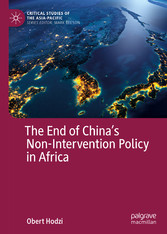Suche
Lesesoftware
Specials
Info / Kontakt

The End of China's Non-Intervention Policy in Africa
von: Obert Hodzi
Palgrave Macmillan, 2018
ISBN: 9783319973494 , 273 Seiten
Format: PDF, Online Lesen
Kopierschutz: Wasserzeichen




Preis: 53,49 EUR
eBook anfordern 
Contents
6
Abbreviations
7
List of Figures
10
List of Tables
11
Chapter 1: Rising Powers and Intervention in Foreign Intrastate Armed Conflicts
12
1.1 Introduction
12
1.2 Making Sense of the Intervention Behaviour of Rising Powers
16
1.3 Why China?
18
1.4 Methodology
22
1.4.1 Selection of Intrastate Armed Conflict Cases for Study
26
1.4.2 Data Collection and Analysis
32
1.5 Definition of Key Terms
34
1.5.1 Intervention
34
1.5.2 Intrastate Armed Conflicts
36
1.6 Book Outline
40
Bibliography
46
Chapter 2: Bringing China into the Foreign Intervention Discourse
49
2.1 Introduction
49
2.2 Intervention in IR: Marginality of Non-Western Rising Powers
50
2.3 Bringing China In
58
2.4 Reimagining Intervention
62
Bibliography
73
Chapter 3: Cyclical Patterns of China’s Intervention Policy
77
3.1 Introduction
77
3.2 Intervention in Imperial China
78
3.3 Incorporation of Imperial China into a Truly International System of States
82
3.4 Reimagining the International and Intervention: China Under Mao
84
3.5 The Beginning of Intervention in African Conflicts by China
87
3.6 China First: Africa in Deng Xiaoping’s China
92
3.7 Prosperous China and Re-emergence of Intervention in Africa
96
3.8 The Cyclical Pattern in China’s External Intervention Behaviour: A Recap
99
Bibliography
108
Chapter 4: Libya
111
4.1 Introduction
111
4.2 Background of China-Libya Relations
112
4.3 Troubled Diplomatic Relations
114
4.4 China-Libya Economic and Trade Engagements
116
4.5 China’s Involvement in Libya’s Industry
119
4.6 Implications of the Libyan Armed Conflict on China’s Economic and Trade Interests
122
4.7 China’s Intervention in Libyan Armed Conflict
125
4.7.1 Non-intervention
126
4.7.2 Transition from Non-intervention to Pragmatic Intervention
130
4.7.3 China’s Complicity in Multilateral Intervention in the Libyan Intrastate Armed Conflict
131
4.7.4 Engagement with the NTC and Mediation Attempts
136
4.7.5 Evacuation and Protection of Chinese Nationals
140
4.8 The Ambivalence of China’s Intervention in Libya
141
Bibliography
149
Chapter 5: Mali
151
5.1 Introduction
151
5.2 China-Mali Political and Diplomatic Relations
152
5.3 Sino-Mali Economic and Trade Relations
155
5.4 Insurrections and Coup d’états: A Test to China’s Non-intervention Principle
158
5.5 From Indifference to “Concern”
161
5.6 From Concern to Rhetorical Support for Mediation
165
5.7 Multilateral Action
167
5.8 Conclusion: Striking a Balance Between Intervention and Non-intervention
169
Bibliography
177
Chapter 6: South Sudan
179
6.1 Introduction
179
6.2 Background of China-South Sudan Relations
180
6.3 The Genesis of Beijing-SPLM Relations
186
6.4 China-SPLM Courtship: Building Relations for a Mutually Beneficial Future?
187
6.5 China in Independent South Sudan
191
6.6 China and the South Sudan Intrastate Armed Conflict
194
6.7 Unilateral and Multilateral Mediation
197
6.8 China as the “Go-Between”
200
6.9 Multilateral Intervention: Leveraging on IGAD
203
6.10 Multilateral Intervention: UN Peacekeeping as a Platform
204
6.11 Conclusion
205
Bibliography
215
Chapter 7: Conclusion: Trends and Patterns of China’s Intervention in Africa
218
7.1 Introduction
218
7.2 Emerging Trends and Patterns
220
7.2.1 Flexible Interpretation of the Non-intervention Principle
221
7.2.2 As China’s Relative Economic Power Increases, Its External Intervention Is Increasing
225
7.2.3 Changes in Perception of Foreign Intrastate Armed Conflicts as Threats Are Leading to More Intervention
230
7.2.4 No Opposition to Intervention by Western Global Powers
231
7.2.5 China Is Increasingly Using UN Peacekeeping Operations to Intervene in Africa
233
7.2.6 From Passive and Inactive to Assertive and Proactive Intervention Approach
237
7.3 Implications for Understandings of Intervention
239
Bibliography
243
Bibliography
247
Index
270






